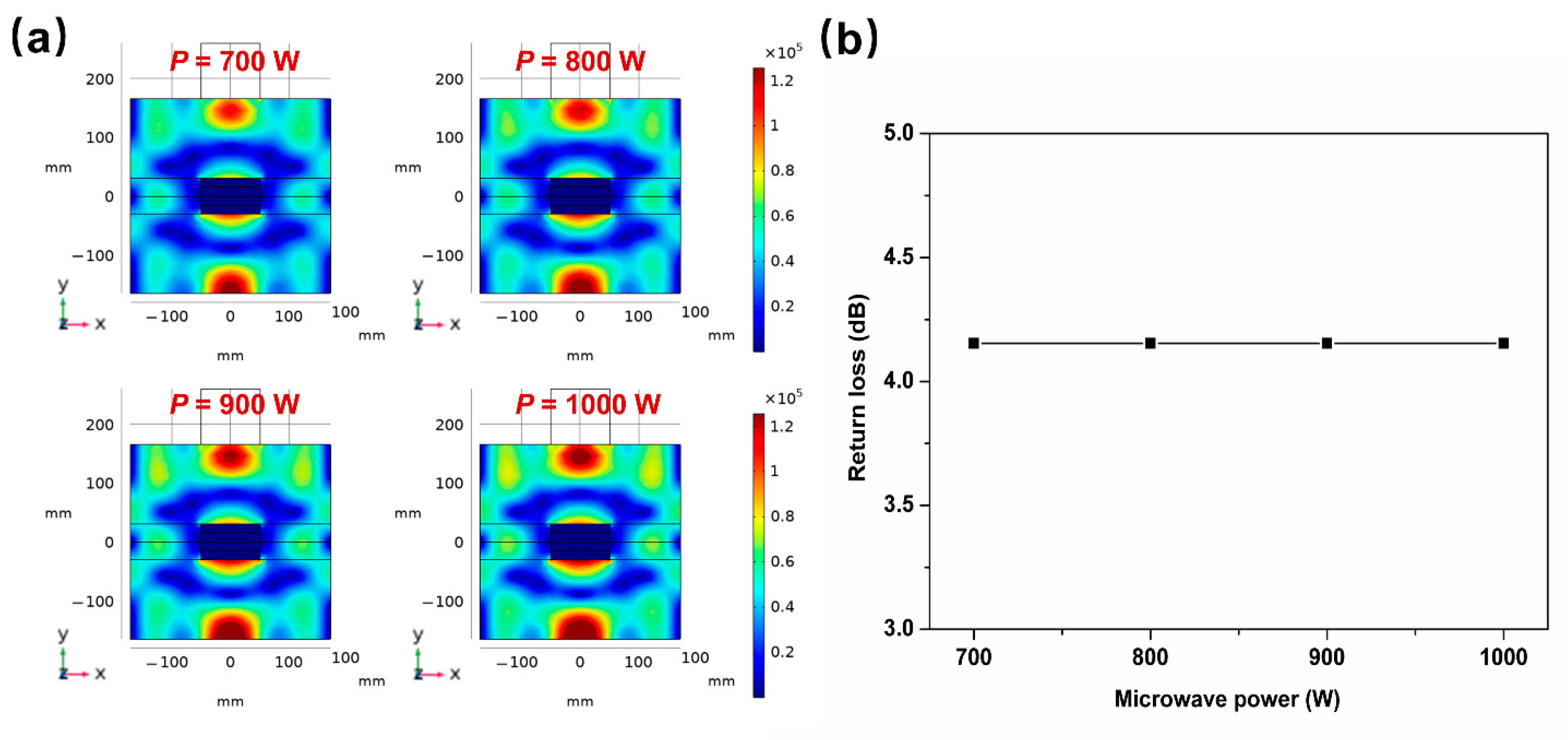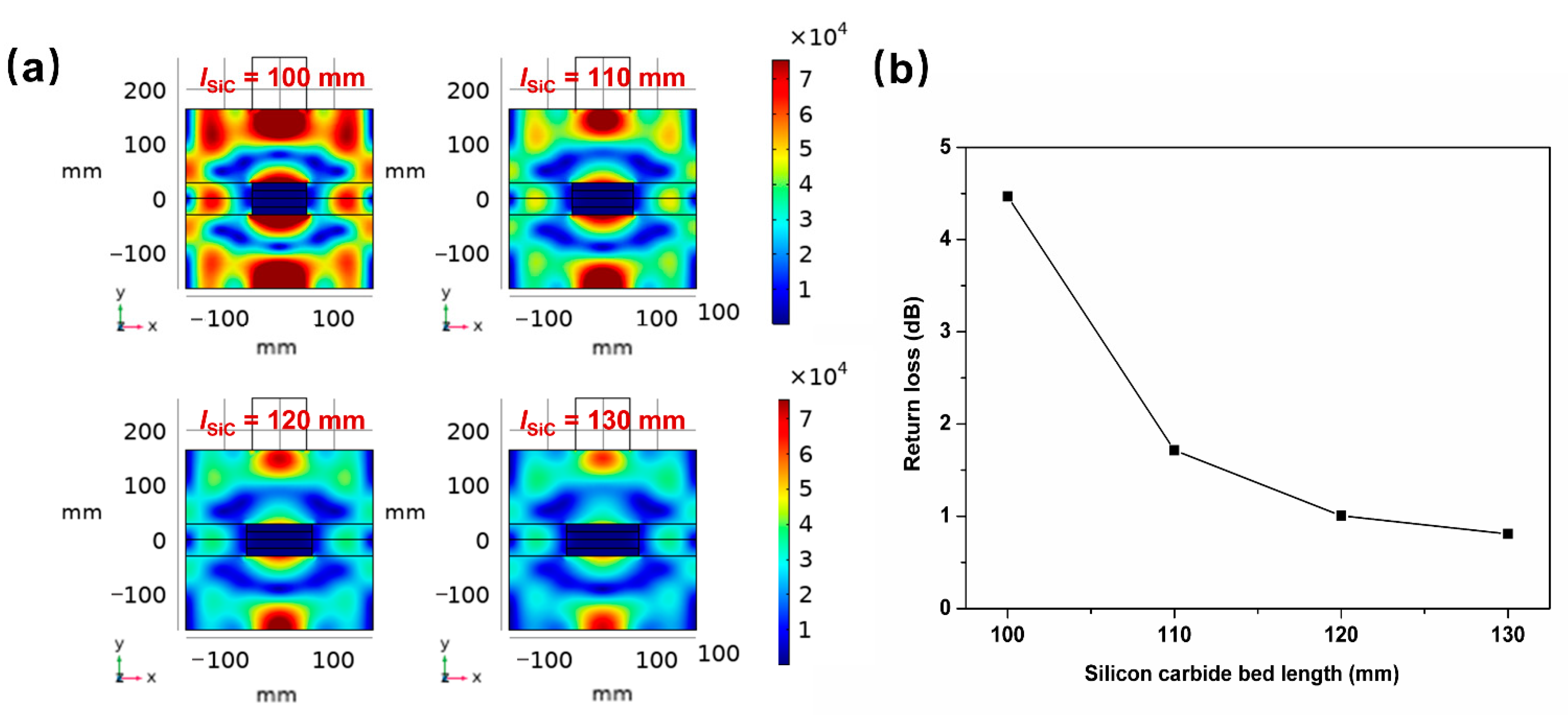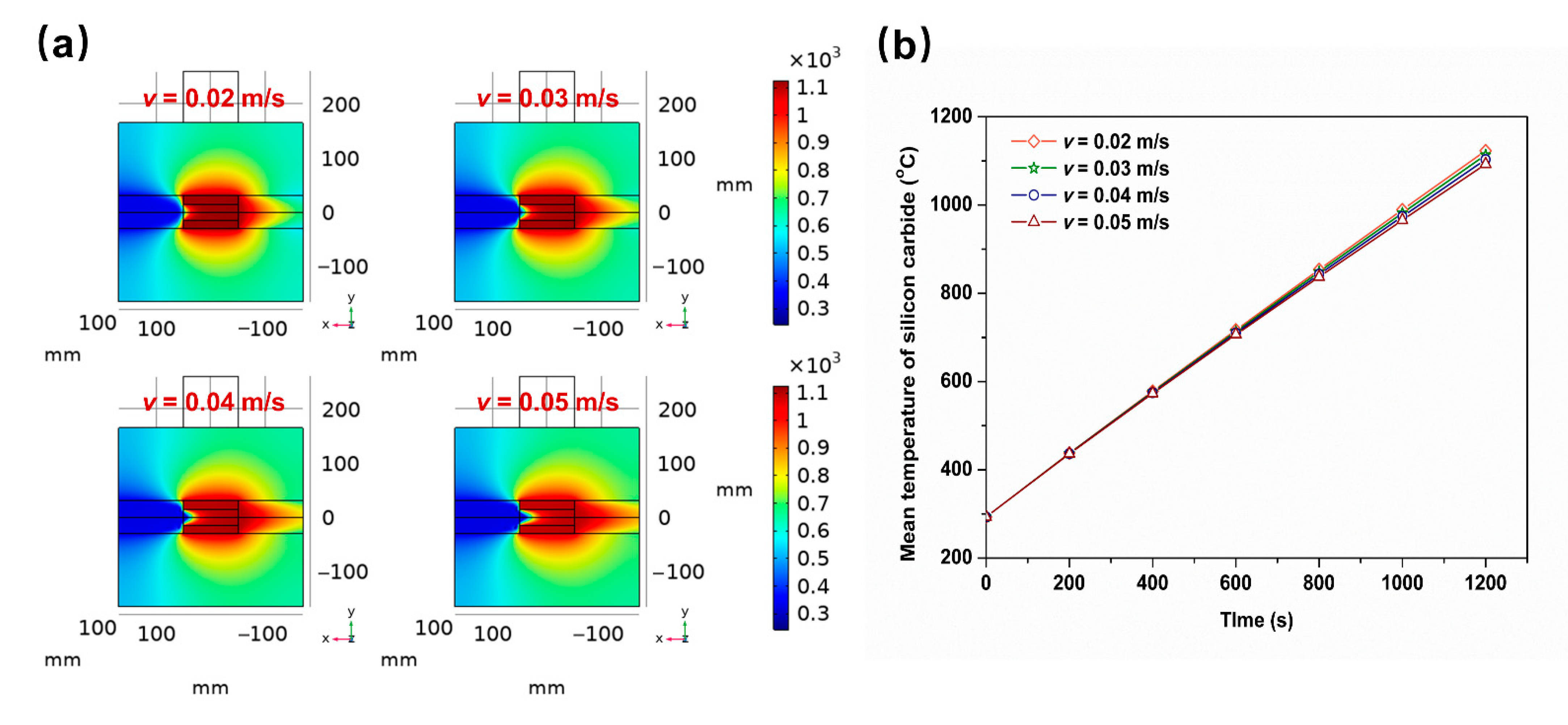Simulation on the Electric and Thermal Fields of a Microwave Reactor for Ex Situ Biomass Tar Elimination
Abstract
:1. Introduction
2. Simulation Methods
2.1. Modeling of the Microwave Reactor
2.2. Parameter Setting
2.3. Evaluation of the Electric and Thermal Fields
3. Results and Discussions
3.1. Effect of Irradiation Feed Position on the Simulated Electric and Thermal Fields
3.2. Effect of Microwave Power on the Simulated Electric and Thermal Fields
3.3. Effect of Silicon Carbide Bed Length on the Simulated Electric and Thermal Fields
3.4. Effect of Flow Velocity on the Simulated Thermal Fields
4. Conclusions
- (1)
- The irradiation feed position that locates 5 mm vertically to the silicon carbide plane (zi = 5 mm) obtains the highest electric intensity on the silicon carbide bed. At this feed position, the silicon carbide can reach the highest temperature and fastest heating rate after wave absorbing, achieving the highest heating efficiency and energy utilization. Placing the waveguide and quartz tube on the same plane will result in the lowest energy utilization because of severe wave reflection.
- (2)
- As the microwave power increases from 700 W to 1000 W, the temperature and heating rate of silicon carbide obviously increase, but the electric field distribution and microwave return loss changes little. The effect of silicon carbide bed length on electric fields is remarkable because of the microwave return loss. Extending the bed length from 100 mm to 130 mm will obviously decrease the bed temperature, as well as the heating rate. A high flow velocity leads to obvious non-uniform temperature distribution on silicon carbide because of the blowing of the cold carrier gas.
- (3)
- To achieve a high microwave energy utilization and uniform bed temperature distribution, a suitable irradiation feed position (zi = 5 mm), high microwave power (P = 1000 W), short silicon carbide bed length (lSiC = 100 mm) and low flow velocity (v = 0.02 m/s) are preferred. However, determination of these parameters in a practical application of biomass tar elimination should also consider the other conditions such as chemical kinetics, treatment capacity and the temperature requirement.
Author Contributions
Funding
Institutional Review Board Statement
Informed Consent Statement
Conflicts of Interest
References
- Han, J.; Kim, H. The reduction and control technology of tar during biomass gasification/pyrolysis: An overview. Renew. Sustain. Energy Rev. 2008, 12, 397–416. [Google Scholar] [CrossRef]
- Li, C.; Suzuki, K. Tar property, analysis, reforming mechanism and model for biomass gasification—An overview. Renew. Sustain. Energy Rev. 2009, 13, 594–604. [Google Scholar] [CrossRef]
- Liu, W.J.; Li, W.W.; Jiang, H.; Yu, H.Q. Fates of chemical elements in biomass during its pyrolysis. Chem. Rev. 2017, 117, 6367–6398. [Google Scholar] [CrossRef] [PubMed]
- Guo, F.; Dong, Y.; Zhang, T.; Dong, L.; Guo, C.; Rao, Z. Experimental study on herb residue gasification in an air-blown circulating fluidized bed gasifier. Ind. Eng. Chem. Res. 2014, 53, 13264–13273. [Google Scholar] [CrossRef]
- Zhang, X.; Chen, Z.; Cheng, L.; Xu, L.; Bi, X.; Liu, Q. Valorization of fluid petroleum coke for efficient catalytic destruction of biomass gasification tar. J. Hazard. Mater. 2022, 424, 127297. [Google Scholar] [CrossRef]
- Li, X.; Liu, P.; Chen, W.; Wu, Y.; Lei, T.; Huang, S.; Li, Y.; Wu, S.; Wang, Z. Catalytic pyrolysis of toluene as biomass tar model component using Ni/HZSM-5 modified by CeO2 and MgO promoters. J. Anal. Appl. Pyrolysis 2022, 162, 105436. [Google Scholar] [CrossRef]
- Heidenreich, S.; Foscolo, P.U. New concepts in biomass gasification. Prog. Energy Combust. Sci. 2015, 46, 72–95. [Google Scholar] [CrossRef]
- Janajreh, I.; Raza, S.S.; Valmundsson, A.S. Plasma gasification process: Modeling, simulation and comparison with conventional air gasification. Energy Convers. Manag. 2013, 65, 801–809. [Google Scholar] [CrossRef]
- Devi, L.P.K.; Janssen, F.J.J.G. A review of the primary measures for tar elimination in biomass gasification processes. Biomass Bioenergy 2003, 24, 125–140. [Google Scholar] [CrossRef]
- Zeng, X.; Ueki, Y.; Yoshiie, R.; Naruse, I.; Wang, F.; Han, Z.; Xu, G. Recent progress in tar removal by char and the applications: A comprehensive analysis. Carbon Resour. Convers. 2020, 3, 1–18. [Google Scholar] [CrossRef]
- Anis, S.; Zainal, Z.A. Tar reduction in biomass producer gas via mechanical, catalytic and thermal methods: A review. Renew. Sustain. Energy Rev. 2011, 15, 2355–2377. [Google Scholar] [CrossRef]
- Shen, Y.; Yoshikawa, K. Recent progresses in catalytic tar elimination during biomass gasification or pyrolysis—A review. Renew. Sustain. Energy Rev. 2013, 21, 371–392. [Google Scholar] [CrossRef]
- Guan, G.; Kaewpanha, M.; Hao, X.; Abudula, A. Catalytic steam reforming of biomass tar: Prospects and challenges. Renew. Sustain. Energy Rev. 2016, 58, 450–461. [Google Scholar] [CrossRef] [Green Version]
- Chan, F.L.; Tanksale, A. Review of recent developments in Ni-based catalysts for biomass gasification. Renew. Sustain. Energy Rev. 2014, 38, 428–438. [Google Scholar] [CrossRef]
- Abdoulmoumine, N.; Adhikari, S.; Kulkarni, A.; Chattanathan, S. A review on biomass gasification syngas cleanup. Appl. Energy 2015, 155, 294–307. [Google Scholar] [CrossRef]
- Cheng, L.; Wu, Z.; Zhang, Z.; Guo, C.; Ellis, N.; Bi, X.; Paul Watkinson, A.; Grace, J.R. Tar elimination from biomass gasification syngas with bauxite residue derived catalysts and gasification char. Appl. Energy 2020, 258, 114088. [Google Scholar] [CrossRef]
- Hervy, M.; Weiss-Hortala, E.; Pham Minh, D.; Dib, H.; Villot, A.; Gérente, C.; Berhanu, S.; Chesnaud, A.; Thorel, A.; Le Coq, L.; et al. Reactivity and deactivation mechanisms of pyrolysis chars from bio-waste during catalytic cracking of tar. Appl. Energy 2019, 237, 487–499. [Google Scholar] [CrossRef] [Green Version]
- Motasemi, F.; Afzal, M.T. A review on the microwave-assisted pyrolysis technique. Renew. Sustain. Energy Rev. 2013, 28, 317–330. [Google Scholar] [CrossRef]
- Beneroso, D.; Bermúdez, J.M.; Montes-Morán, M.A.; Arenillas, A.; Menéndez, J.A. Microwave-induced cracking of pyrolytic tars coupled to microwave pyrolysis for syngas production. Bioresour. Technol. 2016, 218, 687–691. [Google Scholar] [CrossRef] [Green Version]
- Muley, P.D.; Henkel, C.E.; Aguilar, G.; Klasson, K.T.; Boldor, D. Ex situ thermo-catalytic upgrading of biomass pyrolysis vapors using a traveling wave microwave reactor. Appl. Energy 2016, 183, 995–1004. [Google Scholar] [CrossRef] [Green Version]
- Guo, F.; Dong, Y.; Tian, B.; Du, S.; Liang, S.; Zhou, N.; Wang, Y.; Chen, P.; Ruan, R. Applications of microwave energy in gas production and tar removal during biomass gasification. Sustain. Energy Fuels 2020, 4, 5927–5946. [Google Scholar] [CrossRef]
- Li, J.; Tao, J.; Yan, B.; Jiao, L.; Chen, G.; Hu, J. Review of microwave-based treatments of biomass gasification tar. Renew. Sustain. Energy Rev. 2021, 150, 111510. [Google Scholar] [CrossRef]
- Valderrama Rios, M.L.; González, A.M.; Lora, E.E.S.; Almazán del Olmo, O.A. Reduction of tar generated during biomass gasification: A review. Biomass Bioenergy 2018, 108, 345–370. [Google Scholar] [CrossRef]
- Kostyniuk, A.; Grilc, M.; Likozar, B. Catalytic cracking of biomass-derived hydrocarbon tars or model compounds to form biobased benzene, toluene, and xylene isomer mixtures. Ind. Eng. Chem. Res. 2019, 58, 7690–7705. [Google Scholar] [CrossRef] [Green Version]
- Li, J.; Tao, J.; Yan, B.; Cheng, K.; Chen, G.; Hu, J. Microwave reforming with char-supported nickel-cerium catalysts: A potential approach for thorough conversion of biomass tar model compound. Appl. Energy 2020, 261, 114375. [Google Scholar] [CrossRef]
- Chen, G.; Li, J.; Cheng, Z.; Yan, B.; Ma, W.; Yao, J. Investigation on model compound of biomass gasification tar cracking in microwave furnace: Comparative research. Appl. Energy 2018, 217, 249–257. [Google Scholar] [CrossRef]
- Zhang, Y.; Song, Z.; Yan, Y.; Zhao, X.; Sun, J.; Mao, Y.; Wang, W. Performance of Fe/SiC catalysts for cracking of toluene under microwave irradiation. Int. J. Hydrogen Energy 2018, 43, 7227–7236. [Google Scholar] [CrossRef]
- Claude, V.; Courson, C.; Köhler, M.; Lambert, S.D. Overview and essentials of biomass gasification technologies and their catalytic cleaning methods. Energy Fuels 2016, 30, 8791–8814. [Google Scholar] [CrossRef]
- Li, J.; Jiao, L.; Tao, J.; Chen, G.; Hu, J.; Yan, B.; Mansour, M.; Guo, Y.; Ye, P.; Ding, Z.; et al. Can microwave treat biomass tar? A comprehensive study based on experimental and net energy analysis. Appl. Energy 2020, 272, 115194. [Google Scholar] [CrossRef]
- Salema, A.A.; Afzal, M.T. Numerical simulation of heating behaviour in biomass bed and pellets under multimode microwave system. Int. J. Therm. Sci. 2015, 91, 12–24. [Google Scholar] [CrossRef]
- Zhou, R.; Yang, X.; Sun, D.; Jia, G. Multiple tube structure for heating uniformity and efficiency optimization of microwave ovens. Eur. Phys. J. Appl. Phys. 2015, 69, 20201. [Google Scholar] [CrossRef]
- Hong, Y.; Lin, B.; Li, H.; Dai, H.; Zhu, C.; Yao, H. Three-dimensional simulation of microwave heating coal sample with varying parameters. Appl. Therm. Eng. 2016, 93, 1145–1154. [Google Scholar] [CrossRef]
- Bird, T.S. Definition and Misuse of Return Loss [Report of the Transactions Editor-in-Chief]. IEEE Antennas Propag. 2009, 51, 166–167. [Google Scholar] [CrossRef]
- Wang, S.; Hu, Z.; Han, Y.; Gu, Z. Effects of magnetron arrangement and power combination of microwave on drying uniformity of carrot. Dry. Technol. 2013, 31, 1206–1211. [Google Scholar] [CrossRef]
- Wang, S.; Yang, R.; Han, Y.; Gu, Z. Effects of magnetron arrangement and power combination on temperature field uniformity of microwave drying of carrot. Dry. Technol. 2016, 34, 912–922. [Google Scholar] [CrossRef]
- Pedreño-Molina, J.L.; Monzó-Cabrera, J.; Catalá-Civera, J.M. Sample movement optimization for uniform heating in microwave heating ovens. Int. J. RF Microw. Comput.-Aided Eng. 2007, 17, 142–152. [Google Scholar] [CrossRef]
- Meredith, R. Engineer’s Handbook of Industrial Microwave Heating; The Institution of Electric Engineers: London, UK, 1998. [Google Scholar]
- Ren, J.; Cao, J.; Zhao, X.; Liu, Y. Recent progress and perspectives of catalyst design and downstream integration in biomass tar reforming. Chem. Eng. J. 2022, 429, 132316. [Google Scholar] [CrossRef]
- Ren, J.; Liu, Y.; Zhao, X.; Cao, J. Biomass thermochemical conversion: A review on tar elimination from biomass catalytic gasification. J. Energy Inst. 2020, 93, 1083–1098. [Google Scholar] [CrossRef]
- Samanli, S. A comparison of the results obtained from grinding in a stirred media mill lignite coal samples treated with microwave and untreated samples. Fuel 2011, 90, 659–664. [Google Scholar] [CrossRef]
- Klinbun, W.; Rattanadecho, P.; Pakdee, W. Microwave heating of saturated packed bed using a rectangular waveguide (TE10 mode): Influence of particle size, sample dimension, frequency, and placement inside the guide. Int. J. Heat Mass Transfer 2011, 54, 1763–1774. [Google Scholar] [CrossRef]
- Rattanadecho, P. The simulation of microwave heating of wood using a rectangular wave guide: Influence of frequency and sample size. Chem. Eng. Sci. 2006, 61, 4798–4811. [Google Scholar] [CrossRef]
- Curet, S.; Rouaud, O.; Boillereaux, L. Effect of sample size on microwave power absorption within dielectric materials: 2D numerical results vs. closed-form expressions. AIChE J. 2009, 55, 1569–1583. [Google Scholar] [CrossRef]
- Ayappa, K.G.; Davis, H.T.; Crapiste, G.; Davis, E.A.; Gordon, J. Microwave heating: An evaluation of power formulations. Chem. Eng. Sci. 1991, 46, 1005–1016. [Google Scholar] [CrossRef]
- Brodie, G. The Influence of Load Geometry on Temperature Distribution During Microwave Heating. Trans. ASABE 2008, 51, 1401–1413. [Google Scholar] [CrossRef]









| Item | Material | Property |
|---|---|---|
| Resonant cavity | Air |
|
| Tube | Quartz |
|
| Carrier gas | Nitrogen (gas) |
|
| Wave absorber | Silicon carbide |
|
| Parameters | Variable Range |
|---|---|
| zi (mm) | 0, ±5, ±10, ±15, ±20 |
| P (W) | 700, 800, 900, 1000 |
| lSiC (mm) | 100, 110, 120, 130 |
| v (m/s) | 0.02, 0.03, 0.04, 0.05 |
| Items | Value or Expression |
|---|---|
| Governing equation * | |
| Boundary conditions * | (electric field boundary) (magnetic field boundary) (thermal insulation) |
| Microwave frequency (GHz) | 2.45 |
| Wave mode | TE10 |
| Initial value (K) | 293.15 |
| Absolute pressure (Pa) | 101,325 |
| Grid cell size (m) | 24.47 (maximum) 7.3420 × 10−4 (minimum) |
| Curvature factor | 0.6 |
| Narrow slit interval resolution | 0.5 |
Publisher’s Note: MDPI stays neutral with regard to jurisdictional claims in published maps and institutional affiliations. |
© 2022 by the authors. Licensee MDPI, Basel, Switzerland. This article is an open access article distributed under the terms and conditions of the Creative Commons Attribution (CC BY) license (https://creativecommons.org/licenses/by/4.0/).
Share and Cite
Yang, C.; Ying, K.; Yang, F.; Peng, H.; Chen, Z. Simulation on the Electric and Thermal Fields of a Microwave Reactor for Ex Situ Biomass Tar Elimination. Energies 2022, 15, 4143. https://doi.org/10.3390/en15114143
Yang C, Ying K, Yang F, Peng H, Chen Z. Simulation on the Electric and Thermal Fields of a Microwave Reactor for Ex Situ Biomass Tar Elimination. Energies. 2022; 15(11):4143. https://doi.org/10.3390/en15114143
Chicago/Turabian StyleYang, Cheng, Kanfeng Ying, Fan Yang, Huanghu Peng, and Zezhou Chen. 2022. "Simulation on the Electric and Thermal Fields of a Microwave Reactor for Ex Situ Biomass Tar Elimination" Energies 15, no. 11: 4143. https://doi.org/10.3390/en15114143





